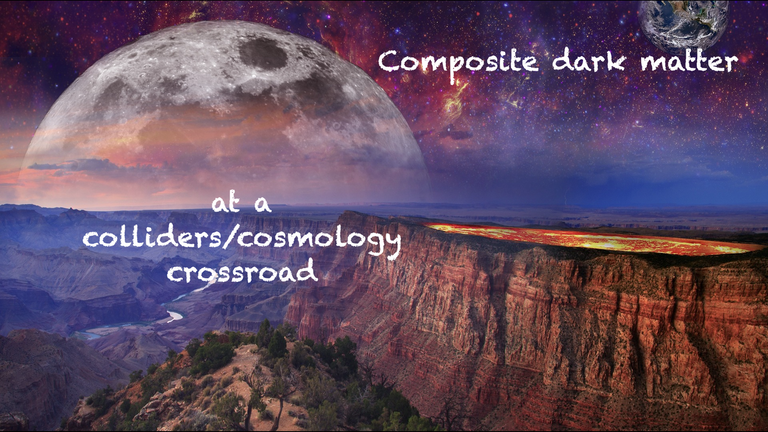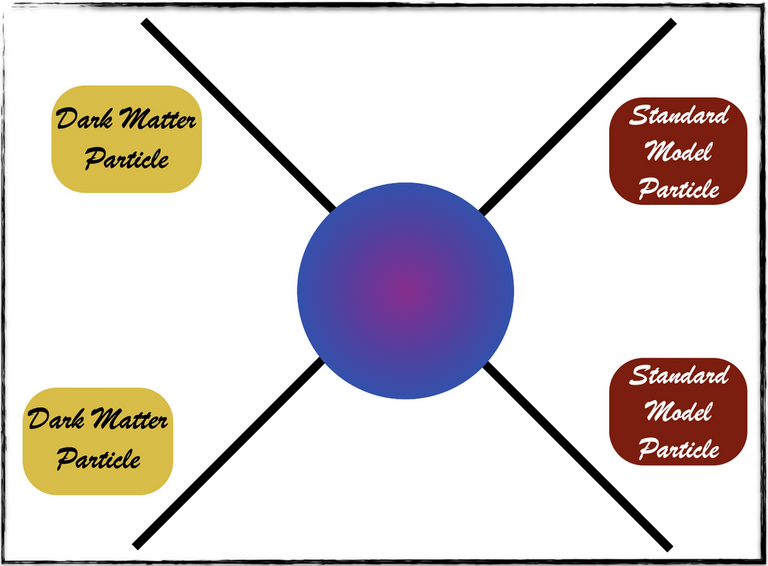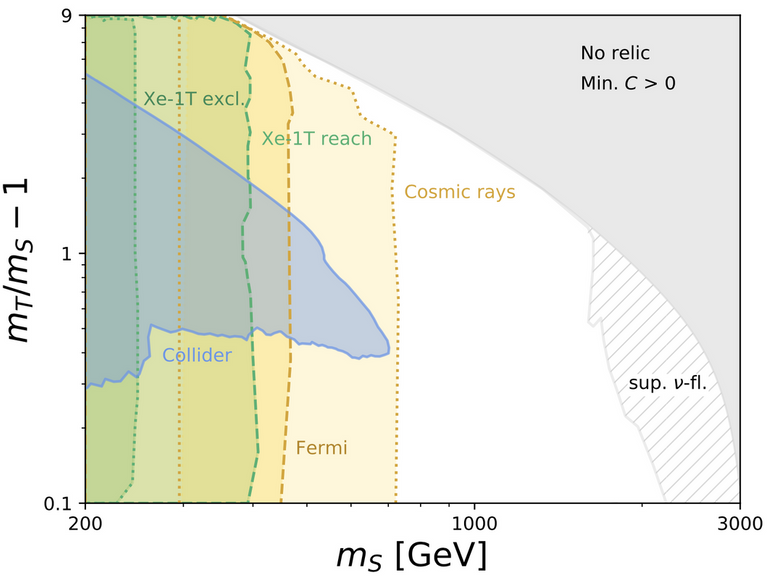As a first physics post after my off-chain time, I come back to the topic of composite models. In the present blog, I focus on their dark side, namely one of the connections of those models with dark matter.
As usual, those pushed for time can finish reading the introduction to this post before moving on with its summary at the end. For others who may be happy to get more physics details, don’t hesitate to read it entirely. I begin with a small recap on composite models in the next section, before presenting another recap in the next-to-following section, but this time on dark matter. Only after this I move on with my own research and discuss a few new results for composite dark matter (taken from this scientific publication of mine).
As the Standard Model of particle physics is full of conceptual issues and limitations, the study of phenomena beyond it consist of a very active field of research for several decades. Among all the existing choices for theories beyond the Standard Model, composite models are very popular.
A composite theory typically includes two classes of particles: elementary particles like most particles of the Standard Model, and composite ones that are made of heavy fundamental particles that still need to be discovered. In general (i.e. with few exceptions), all composite particles are heavy (as what they are made of is heavy too). There are thus a lot of efforts to find them at energetic colliders like CERN’s Large Hadron Collider.
For the topic discussed in the current blog, I consider those heavy particles, also called heavy composite resonances. There is a full zoo of them, and it is not unlikely that one of them could play the role of dark matter. In this case, there is also often at least another one that connects the dark matter to the Standard Model of particle physics.
This connection equips composite dark matter with interesting properties that yield its potential detection through cosmic rays or direct searches for dark matter on Earth. This is what is discussed in the research article to which this blog is dedicated.

[Credits: Original image by karlfrey (Pixabay)]
Compositeness in a nutshell
As said above, composite models consist of an interesting option for physics beyond the Standard Model of particle physics. In such frameworks, the particle content of the theory is divided in two.
- On the one hand, we have all the particles of the Standard Model with the exception of the Higgs boson. This sector of the theory is called the elementary sector as we know that the Standard Model particles cannot be composite.
- On the other hand, we have a second sector of particles containing new heavier fundamental particles. They form composite particles by virtue of a new fundamental interaction, and these particles belong to what we call the composite sector of the theory.
The way the dynamics of the composite sector works leads to the appearance of very light composite particles. One of them can be identified with the Higgs boson of the Standard Model. As we have a decade of data explaining what the properties of the Higgs boson could be and could not be, this restrains quite significantly how composite models could be. They are however not excluded so far!
In addition, some of the composite resonances are special in the sense that they are responsible for explaining the masses of heavy Standard Model particles like the top quark. For that reason, they are actively searched for (without success so far) at collider experiments.
Moreover, often one of these heavy resonances have properties that make it a suitable particle to play the role of dark matter, one of the most searched for substance in the universe.
The research study to which this blog is dedicated focuses on this corner of composite models. It investigates the properties of the resonance that plays the role of dark matter and of that which provides the top quark its large mass. These two resonances of course interact with each other, and an important question to ask is whether this interaction is sufficient to have a dark matter particle with properties in agreement with current observations.
Before bringing an answer to this question, let’s discuss briefly why dark matter is important, and how to search for it.

[Credits: ThomasWolter (Pixabay)]
Dark matter, its motivation and how to search for it
Dark matter is definitely one the most elusive substance ever searched for. There are striking signs that it should be there. Moreover, from its expected properties we should be able to find it, here on Earth or there in the sky.
Dark matter has been initially hypothesised by Zwicky and then by Rubin to solve the mysteries of the galaxy rotation curves. In a few words, stars were observed (almost a hundred years ago) to rotate too fast around the galactic centres relative to predictions made with the theory of gravitation.
In order to solve that problem, it was postulated that some matter was invisible and therefore not accounted for in the calculations. This is how dark matter was born: to restore agreement between data and theory.

[Credits: NASA (CC BY 2.0)]
A bit later (in the 1960s), the cosmic microwave background was discovered. This consists of a fossil radiation filling the entire universe, and whose average temperature is of about 2.73 degrees Kelvin (-270 degrees Celsius or -455 degrees Farenheit). There are however variations from this average of the order of a fraction of a permille. These have been studied closely by numbers of experiments.
The map of those variations provides an imprint of the universe, which shows how it was 380,000 years after the Big Bang. Such a time corresponds to the moment neutral atoms were formed. The observations are extremely clear: dark matter must be around…
In addition (to quote a few more proofs), simulations trying to obtain a universe with a structure matching the observed one only work with dark matter as part of their initial conditions, gravitational lensing shows that there must be some dark matter around, etc.
We therefore know that dark matter exists. However, we have no idea about what it has to be. What is important for us is the following. If we assume dark matter has a particle physics explanation (or in other words that there is a dark matter particle), and if that particle interacts with the Standard Model, then there are various options to search for it.

[Credits: @lemouth]
These options are summarised in the beautiful graph above, where the blob in the middle includes some reaction that we will keep unspecified to simplify the discussion.
We can first take it from the right to the left, which corresponds to a process in which two Standard Model particles react to produce two dark matter particles. Such a process is the key process to produce dark matter at particle colliders. In such machines, we collide two Standard Model particles (for instance the constituents of protons at CERN’s Large Hadron Collider). Therefore, if dark matter satisfies the above properties, then we could potentially produce two dark matter particles, and thus see it at colliders (if it is light enough and with a strong enough connection to the Standard Model).
In addition, the above figure can also be studied from the left to the right. We then have two dark matter particles that annihilate into two Standard Model particles. Such a process can happen in regions of the universe dense in dark matter (and there are such regions) and produce cosmic rays or gamma rays that can be analysed through satellite experiments orbiting close to Earth. This is what is called dark matter indirect detection experiments.
Finally, we can also have a look at the figure from the top to the bottom. This consists of a reaction in which one dark matter particle scatters with one Standard Model particle. This mechanism is that lying at the basis of every single dark matter direct detection experiment on Earth. In practice, we prepare a huge detector to patiently wait for dark matter to go through it, and to hit one of its constituents. Of course we have an apparatus to record that hit, so that we can infer the presence of dark matter.
Cornering composite dark matter
The above three options (colliders, direct detection and indirect detection) provide three means to corner any model of particle physics featuring a dark matter particle. In the research work discussed in this blog, we have applied this to composite dark matter. As no signal has been found, this results in various constraints on any model. The goal is then to see to which extent a given model is still viable.
So let’s go back to our model for a minute. We focus on a part of the composite sector that includes one dark matter particle (that we call S) and one mediator particle (that we call T) that also plays a role in providing an explanation for the mass of the heaviest Standard Model particle, the top quark.
In terms of degrees of freedom, we thus have two masses, the mass of the dark matter particle (mS) and that of the T particle (mT). Instead of the latter, we prefer to equivaletly use the compression between the two masses (mT/mS-1) that is small for new particles that have mostly the same mass and large if T is much heavier than S.
In terms of interactions, composite models predict a connection between the two new particles and the top quark. The strength of this connection provides an extra freedom on the model. In addition, predictions also include a coupling between two dark particles and two top quarks. We thus have two couplings as free parameters, which gives four free parameters in total (two couplings and two masses).
However, life is not entirely free… We must have the right amount of dark matter, which matches observations. This extra constraint makes one of the fourth parameters fixed once the three others are chosen. What we decided to do was to vary the two masses and the coupling between dark matter and the top quark (the second of the two couplings introduced above). The last parameter (the coupling between the T, the S and the top quark) becomes thus fully determined.
We are now ready to answer our question: is the model viable once direct detection, indirect detection and collider bounds are accounted for. The answer is “yes it is”, but composite dark matter is severely constrained. This is illustrated in the figure below.

[Credits: JHEP 07 (2021) 026]
On the x-axis of this plot, we have the dark matter mass (in units of GeV, 1 GeV being the proton mass). On the y-axis, we have the compression factor between the dark matter and the composite T. As said above, for each mass point, we performed a scan over the strength of the dark matter/top-quark coupling and fixed the last parameter (the strength of the interaction between the T, the S and the top quark) so that the model predicts the right amount of dark matter.
For the part of the figure shown in grey, there is no way to get there. For the other parts of the plot, we focus on the minimally possible interaction between the dark matter and the top-quark that was yielding the right amount of dark matter.
In blue stand constraints coming from CERN’s Large Hadron Collider. The latter concern searches for dark matter, but also searches for the T particle. Every setup in this region is excluded. In green come bounds from direct detection and in yellow from cosmic and gamma ray searches. Anything in those contours is excluded too.
This figure demonstrates an interesting complementarity between all types of collider and cosmology searches. It also shows that the model is still viable, provided that dark matter is quite heavy (with a mass of at least 750 GeV). This will make it hard to find in future experiments, although proposals for very energetic colliders should be the way to go.
The dark side of compositeness
Composite models consist of a class of theories beyond the Standard Model of particle physics that feature both a sector of elementary particles (the particles of the Standard Model with the exception of the Higgs boson) and a sector of composite particles formed by new elementary particles. This idea has the advantage to provide a solution to some of the conceptual problems of the Standard Model, and is thus seriously considered in high-energy physics.
Among the new composite particles, we find a particle that is similar to the Higgs boson (otherwise the model would be excluded by data). However, we often find a composite particle that provides an explanation to the large mass of the top quark, and another one that is compatible with the idea of dark matter.
This blog was dedicated to a study of this setup, whose findings have been published in this scientific publication. Composite dark matter and the composite partner of the top quark interact virtuously, so that there exist a wealth of probes of the model. We can hence use results of searches for new phenomena at CERN’s Large Hadron Collider, searches for signals of dark matter in cosmic and gamma rays and direct searches for dark matter on Earth. Collider and cosmology combine nicely to understand particle physics better.
As none of these experiments has seen anything, models are constrained. In terms of composite dark matter, we have found that dark matter must be quite heavy, and that the mass of the composite partner of the top quark is mostly free (as soon as it is heavier than dark matter). This is summarised and illustrated in the last figure of this blog (every point in white is allowed by current data).
We can thus question ourselves about what to do next. There is a long way to go before being able to either fully exclude the model, or to observe one of its signal. What is clear is that the heavy nature of the new particles make them a case for future collider projects.
My collaborators and I have not embarked into such a future collider study, although this may be something to consider soon or later. We will see once we will have a student ready for this. This may also be an interesting thing to do on Hive in the context of a next citizen science project (once the first one will be finished). We will see…
That’s all for today. I wish you all, in the meantime, a very nice week. I will be in Lyon in France during a good half of the week. After this trip and the previous one to MIT, I will then stay calmly in Paris for a few weeks. By the way, more from me and my particle physics #citizenscience project on Hive… hopefully tomorrow (if not, then this will be on Wednesday)!
The rewards earned on this comment will go directly to the person sharing the post on Twitter as long as they are registered with @poshtoken. Sign up at https://hiveposh.com.
I don't know what to say man.
Tried to understand it and it is beyond my capability. 😅
!1UP
Ooh :(
Maybe you can start to say where you disconnected from the blog. Then I will to my best to re-branch you in. I would be very happy to help as much as I could so that you could get a few things out of that (or to provide extra links to get extra pieces of information).
is a beautiful graph.Finally, I put aside everything and begin my physics lesson. Nice to have you back, because that means you are feeling rested. Let me start my response to your blog by saying the best diagram here (because I understood it clearly) was the one created by someone named @lemouth :)) When you described how the different particles might interact (in that diagram) it made perfect sense to me. Indeed, it
As I have stated in comments previously, the wonder, the attraction of your study for me is that you search for something that 'should' be there--dark matter. This has to exist in order for the universe to make sense, as it is understood according to the Standard Model. Anomalies can be rectified with the existence of dark matter. So it must be there. As you say, dark matter was born"
And yet, physics has not been able to prove, absolutely that it does exist. Elusive, necessary, and irresistible.
As always, I thank you for opening a window unto the mysteries of the universe.
Take care, @lemouth.
Regards....
Thanks for passing by! I am a bit rested but still traveling a bit (this time within France). I am finally back home and write the next step in our citizen science project, to be released tomorrow :)
Thanks for appreciating my sense of humour. I actually use the very same graph in official research talks :)
Totally! All our proofs are indirect, and we are still fighting hard to get a direct observation. Hopefully, I will see this within my lifetime ;)
Cheers!
I think my mind is officially blown 🤯🤣
Amazing post! Welcome back!
Thanks for passing by! I hope you managed to understand a few things despite of the damage I made to your brain :D
In any case, please let me know if you have any question! I will be very happy to clarify anything that should be clarified.
Thanks for your contribution to the STEMsocial community. Feel free to join us on discord to get to know the rest of us!
Please consider delegating to the @stemsocial account (85% of the curation rewards are returned).
You may also include @stemsocial as a beneficiary of the rewards of this post to get a stronger support.
You have received a 1UP from @thecuriousfool!
@stem-curator, @vyb-curator, @pob-curator, @neoxag-curator, @pal-curatorAnd they will bring !PIZZA 🍕 The following @oneup-cartel family members will soon upvote your post:
Learn more about our delegation service to earn daily rewards. Join the family on Discord.
PIZZA Holders sent $PIZZA tips in this post's comments:
(12/20) @curation-cartel tipped @lemouth (x1)
Please vote for pizza.witness!
Congratulations @lemouth! You have completed the following achievement on the Hive blockchain and have been rewarded with new badge(s):
Your next target is to reach 90000 upvotes.
You can view your badges on your board and compare yourself to others in the Ranking
If you no longer want to receive notifications, reply to this comment with the word
STOP